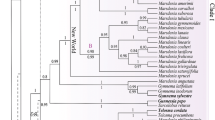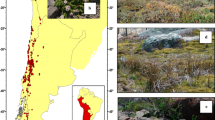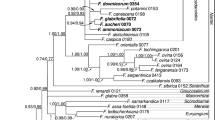Abstract
Phylogenetic relationships within Euphorbiinae were inferred from our analysis of the 3′; end of the chloroplast gene ndhF. A sampling of that subtribe covered 88 species; 3 closely related species from the subtribes Anthosteminae and Neoguillauminiinae and the tiribe Hippomaneae were included as outgroups. A phylogenetic assessment was carried out using the parsimony approach. The relationships revealed via these ndhF data supported the monophyly of subg.Esula, subg.Chamaesyce, subg.Euphorbia, and subg.Lacanthis. However, the polyphyly of subg.Agaloma, subg.Lyciopsis, and subg.Eremophyton also was strongly suggested. The African succulent Euphorbiinae can be divided into primarily two independent groups: 1) spiny succulents, which form a strongly supported clade with three subclades (subg.Euphorbia, subg.Lacanthis, andMonadenium+Synadenium); and 2) non-spiny succulents, which consist of sect.Meleuphorbia, sect.Medusae, sect.Anthacantha, sect.Trichadenia, sect.Pseudeuphorbium, sect.Treisia, and sect.Pseudacalypha. In the ndhF tree, the subg.Esula clade is placed as a sister to the rest of the Euphorbiinae. Thus, the origin of theEuphorbia s.I. should be sought within the herbaceous species of subg.Esula. The core North American endemicEuphorbia groups --Agaloma, Chamaesyce, andPoinsettia — are monophyletic and independent of the South American subg.Agaloma. Instead, they are derived from the AfricanEuphorbia subg.Lyciopsis andEremophyton. The Eurasian subg.Esula clade forms two subclades, which are concordant to sect.Esula and sect.Tithymalus.
Similar content being viewed by others
Literature Cited
Boissier PE (1862) Euphorbiaceae, subordo Euphorbieae.In A de Candolle, ed, Prodromus Systematis Naturalis Regni Vegetalis 15. Masson and Son, Paris, pp 3–188
Carter S (1985) New species and taxonomic changes inEuphorbia from East and Northeast tropical Africa and a new species from Oman. Kew Bull40: 809–825
Carters (1988) Euphorbiaceae.In RM Polhill, ed, Flora of Tropical East Africa. Balkema, Rotterdam, pp 409–567
Carter S (1994) A preliminary classification ofEuphorbia subgenusEuphorbia. Ann Missouri Bot Card81: 368–379
Croizat L (1972) An introduction of the subgeneric classification ofEuphorbia L., with stress on the south African and Malagasy species. III. Webbia27: 1–221
Doyle JJ, Doyle JL (1987) A rapid isolation procedure for small quantities of fresh leaf material. Phytochem Bull19: 11–15
Dressier RL (1957) The genusPedilanthus (Euphorbiaceae). Contrib Gray Herb182: 1–188
Dressier RL (1961) A synopsis ofPoinsettia (Euphorbiaceae). Ann Missouri Bot Card48: 329–341
Felsenstein J (1985) Confidence limits on phylogenies: An approach using the bootstrap. Evolution39: 783–791
Gilbert MG (1987) Two new geophytic species ofEuphorbia with comments on the subgeneric grouping of its African members. Kew Bull42: 231–244
Govaerts R, Frodin DG, Radcliffe-Smith A (2000) World Checklist and Bibliography of Euphorbiaceae, Vol 2. The Royal Botanic Gardens, Kew
Haevermans T, Hoffmann P, Lowry II PP, Labat J-N, Randrianjohany E (2004) Phylogenetic analysis of the MadagascanEuphorbia subgenusLacanthis based on ITS sequence data. Ann Missouri Bot Gard91: 247–259
Haworth AH (1812) Synopsis Plantarum Succulentarum. Richard Taylor, London
Klotzsch F (1859) Hr. Klotsch lass uber Linne’s naturliche Pflanzenklasse Tricoccae des Berliner Herbarium’s im Allegemeinen und die naturliche Ordnung Euphorbiaceae insbesondere. Monatsber. Konigl. Preuss. Akad. Wiss. Berlin1859: 236–254
Kuzmanov B (1964) On the origin ofEuphorbia subg.Esula in Europe (Euphorbiaceae). Blumea12: 369–379
Loockerman DJ, Jansen RK (1996) The use of herbarium material for molecular systematic studies.In T Stuessy SH Sohmer, eds, Sampling the Green World. Columbia University Press, New York, pp 205–220
Olmstead RG, Sweere JA (1994) Combining data in phylogenetic systematics: An empirical approach using three molecular data sets in the Solanaceae. Syst Biol43: 467–481
Park K-R (1996) Phylogeny of New World subtribe Euphorbiinae (Euphorbiaceae). Korean J Plant Taxon26: 235–256
Park K-R, Elisens WJ (2000) A phylogenetic study of tribe Euphorbieae (Euphorbiaceae). Intl J Plant Sci161: 425–434
Park K-R, Backlund A (2002) Origin of the cyathium-bearing Euphorbieae (Euphorbiaceae): Phylogenetic study based on morphological characters. Bot Bull Acad Sin43: 57–62
Pax F, Hoffmann K (1931) Euphorbiaceae.In A Engler, K Prantl, eds, Die Naturlichen Pflanzenfamilien. 2nd Ed, 19 c. Engelmann, Leipzig, pp 11–233
Rafinesque CS (1836) Flora Telluriana (Parts IV et Ult.), Probasco, H, Philadelphia, pp 116–117
Ritz CM, Zimmermann NFA, Hellwig FH (2003) Phylogeny of sub-sect.Meleuphorbia (A. Berger) Pax &Hoffm. (Euphorbia L.) reflects the climatic regime in South Africa. Plant Syst Evol241: 245–259
Steinmann VW, Porter JM (2002) Phylogenetic relationships in Euphorbieae (Euphorbiaceae) based on ITS and ndhF sequence data. Ann Missouri Bot Gard89: 453–490
Swofford DL (2002) RAUP* Phylogenetic Analysis Using Parsimony (*And Other Methods). Version 4.10b. Sinauer Associates, Sunderland, MA, USA
Thompson JD, Gibson TJ, Plewniak F, Jeanmougin F, Higgins DG (1997) The Clustal X windows interface: Flexible strategies for multiple sequence alignment aided by quality analysis tools. Nucl Acids Res24: 4876–4882
Urbatsch LE, Bacon JD, Hartman RL, Johnston MC, Watson TJ, Webster GL (1975) Chromosome numbers for North American Euphorbiaceae. Amer J Bot62: 494–500
Webster GL (1967) The genera Euphorbiaceae in the southeastern United States. J Arnold Arbor48: 303–430
Wheeler LC (1939) A miscellany of New World Euphorbiaceae II. Contrib Gray Herb127: 48–78
Wheeler LC (1943) The genera of living Euphorbieae. Amer Mid Nat30: 456–503
Author information
Authors and Affiliations
Corresponding author
Rights and permissions
About this article
Cite this article
Park, KR., Jansen, R.K. A Phylogeny of Euphorbieae Subtribe Euphorbiinae (Euphorbiaceae) Based on Molecular Data. J. Plant Biol. 50, 644–649 (2007). https://doi.org/10.1007/BF03030608
Received:
Accepted:
Issue Date:
DOI: https://doi.org/10.1007/BF03030608




